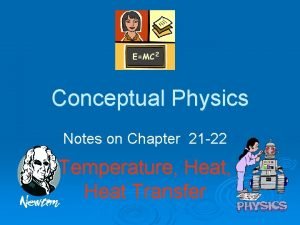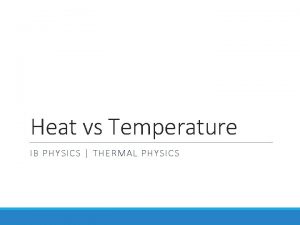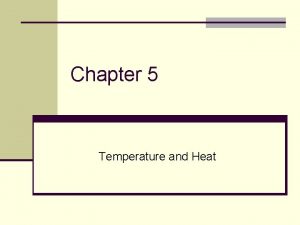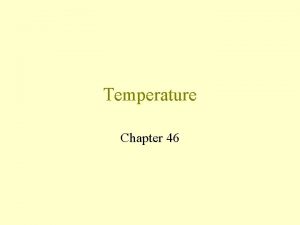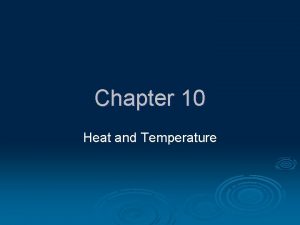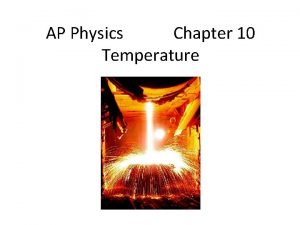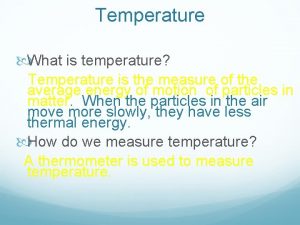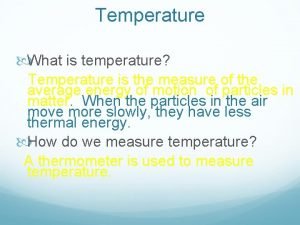Conceptual Physics Notes on Chapter 21 22 Temperature












- Slides: 12

Conceptual Physics Notes on Chapter 21 -22 Temperature, Heat Transfer

Temperature, Heat Transfer Ø This is going to be a REVIEW of last years chemistry class. Ø However, we are going to look at this from a PHYSICS perspective.

Temperature, Heat Transfer Ø All matter is composed of “jiggling” atoms. This matter has kinetic energy (Ch. 8). Ø This kinetic energy causes an effect we call warmth or TEMPERATURE. Ø Cold objects have Less kinetic energy. Ø Hot objects have More kinetic energy.

Temperature, Heat Transfer Ø Most objects expand when it gains energy and contracts when it losses energy. A Thermometer is a good example. Ø Ø Ø Celsius Scale Fahrenheit Scale Kelvin Scale Ø Ø Ø Celsius Scale – named in honor of astronomer Andres Celsius (1701 – 1744). Fahrenheit Scale - named in honor of German physicist Gabriel Fahrenheit (1686 – 1736). Kelvin Scale - named in honor of British physicist Lord Kelvin (1824 – 1907).

Temperature, Heat Transfer Ø The energy that transfers from one object to another because of a temperature difference between them is called HEAT. l Note: Matter DOES NOT contain heat. • Matter contains ENERGY in the form of heat. Ø The grand total of all energies inside a substance is called INTERNAL ENERGY. l A substance that does not contain heat, still contains internal energy (atoms vibrating).

Temperature, Heat Transfer Measurement of Heat Ø The most common unit of heat is the CALORIE. The calorie is defined as the amount of heat required to raise the temperature of 1 gram of water by 1°C. Ø IMPORTANT: Calorie and calorie are both units of energy. Calorie is the Food version.

Temperature, Heat Transfer Specific Heat Capacity Ø Different objects have different capacities for storing internal energy. l Ø Aluminum foil cools very rapidly…food in container does not! We call this Specific heat capacity.

Temperature, Heat Transfer Applications Ø This leads to increased “jiggle” of atoms which tend to move apart. The result is EXPANSION of the substance. l Bimetallic strip … Thermostat l Bridge Gaps l Jar lids

Temperature, Heat Transfer Conduction, Convection, Radiation Ø Conduction l Ø Convection l Ø The direct transfer or movement of warmth and energy from one molecule to another molecule by collision. The organized motion or movement of large groups of molecules based on their relative densities or temperatures. Radiation l The method by which the sun's energy reaches the earth

Temperature, Heat Transfer Newton’s Law of Cooling Ø Newton's Law of Cooling states that the rate of change of the temperature of an object is proportional to the difference between its own temperature and the ambient temperature (i. e. the temperature of its surroundings).

Temperature, Heat Transfer Global Warming & the Greenhouse Effect Ø Earth’s atmosphere is transparent to solar energy. This traps the energy…the greenhouse effect.

Temperature, Heat Transfer Global Warming & the Greenhouse Effect Ø This is good in that it helps heat the earth. l HOWEVER…to much heating leads to global warming.
 Chapter 8 energy conceptual physics
Chapter 8 energy conceptual physics Conceptual physics chapter 4
Conceptual physics chapter 4 Chapter 30 lenses
Chapter 30 lenses Conceptual physics notes
Conceptual physics notes Conceptual physics chapter 7 momentum answers
Conceptual physics chapter 7 momentum answers Conceptual physics chapter 35
Conceptual physics chapter 35 Chapter 33 conceptual physics
Chapter 33 conceptual physics Chapter 32 conceptual physics
Chapter 32 conceptual physics Chapter 27 light conceptual physics
Chapter 27 light conceptual physics Conceptual physics chapter 26
Conceptual physics chapter 26 Conceptual physics chapter 21
Conceptual physics chapter 21 Conceptual physics chapter 13 universal gravitation
Conceptual physics chapter 13 universal gravitation Chapter 6 momentum changing momentum
Chapter 6 momentum changing momentum










